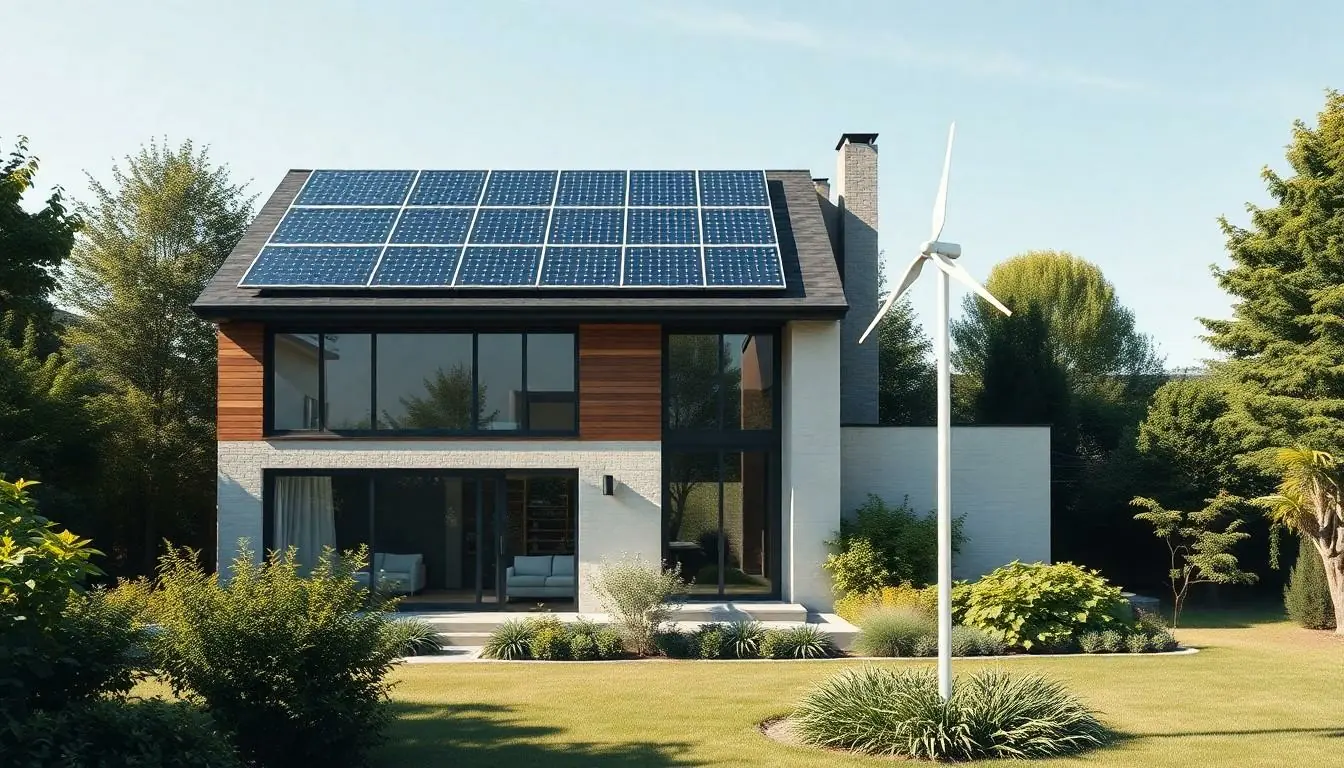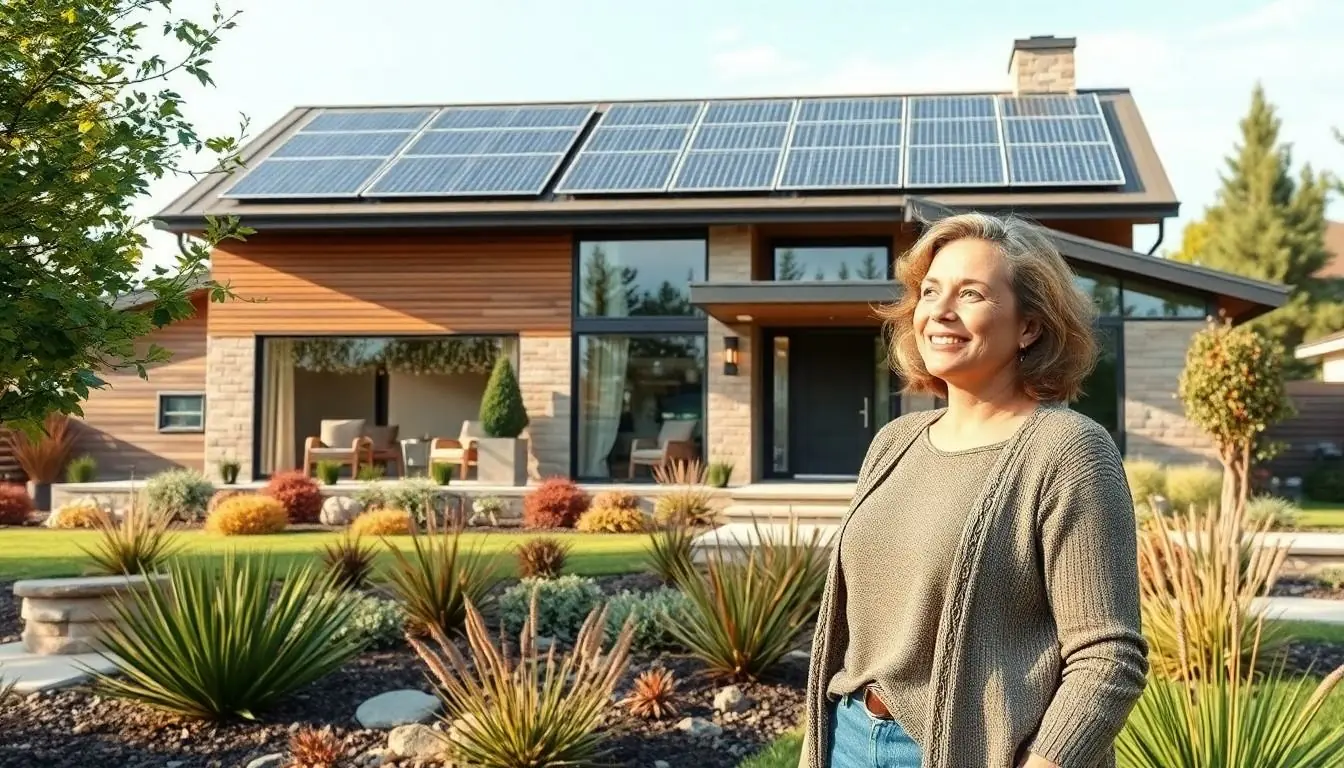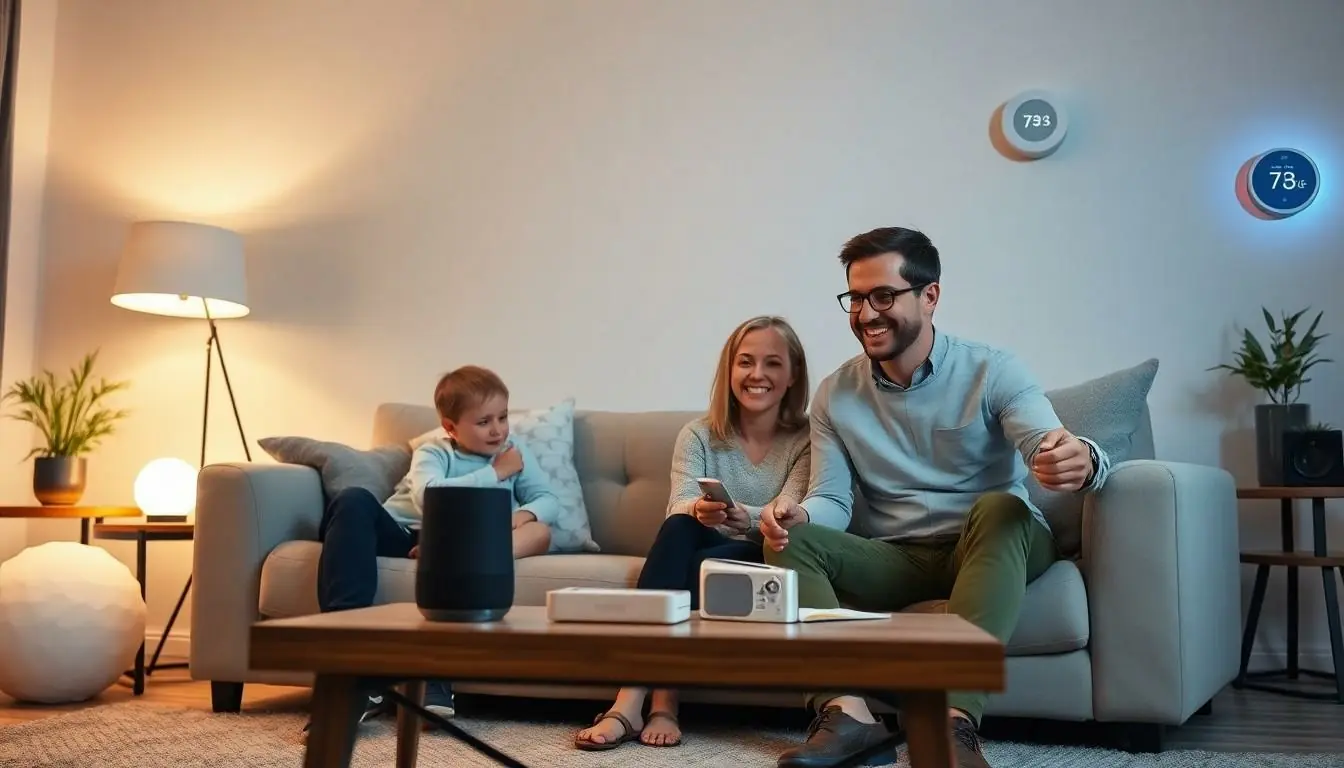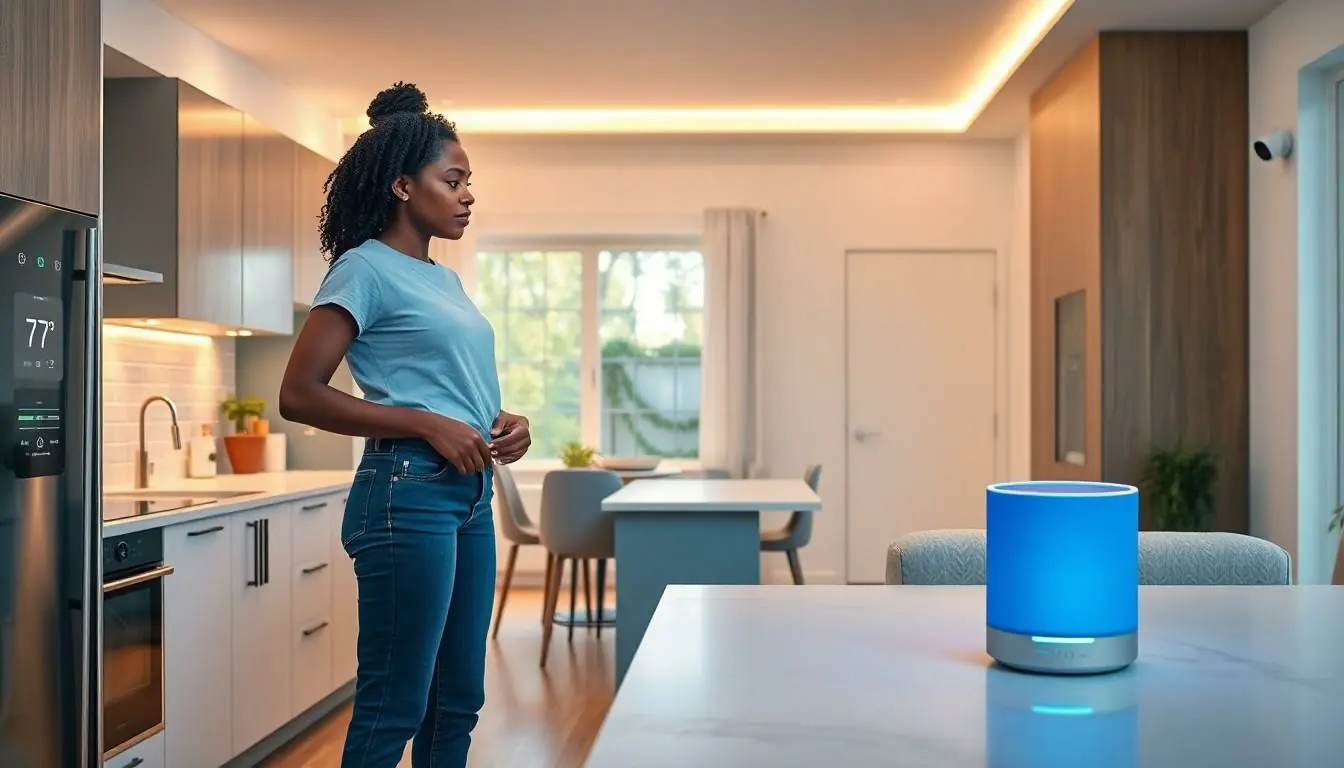Imagine living in a home that not only makes your life easier but also helps save the planet. Eco-friendly smart homes are the superheroes of modern living, combining cutting-edge technology with sustainable practices. They’re like the Swiss Army knives of houses—efficient, versatile, and good for the environment.
Picture this: your thermostat knows when you’re home, adjusting the temperature to keep you cozy while saving energy. Your lights turn off automatically when you leave a room, preventing that awkward moment when you realize you left the living room glowing like a disco ball. With eco-friendly smart homes, you can enjoy comfort and convenience while giving Mother Earth a high-five. Why not embrace a lifestyle that’s both smart and sustainable? It’s not just a trend; it’s a way to make a positive impact while enjoying the perks of modern technology.
Table of Contents
ToggleUnderstanding Eco-Friendly Smart Homes
Eco-friendly smart homes integrate advanced technology with sustainable living practices. These residences prioritize energy efficiency, reducing their environmental impact while enhancing comfort.
Definition and Features
Eco-friendly smart homes utilize innovative technologies to create sustainable living environments. Smart thermostats adjust temperatures based on occupancy, promoting energy savings. Solar panels generate renewable energy, decreasing reliance on non-renewable sources. Smart meters monitor electricity usage in real-time, allowing homeowners to track and optimize consumption. Automated lighting systems turn off lights when a room is unoccupied, further conserving energy. Such homes often feature smart appliances designed to use less water and electricity, significantly reducing the overall carbon footprint.
Benefits of Eco-Friendly Smart Homes
Eco-friendly smart homes offer numerous advantages for residents and the environment. Energy savings result in lower utility bills, benefiting homeowners financially. Enhanced comfort and convenience come from customizable settings tailored to individual preferences. Sustainability fosters a healthier living environment, with improved air quality through better ventilation. Reduced greenhouse gas emissions contribute positively to global ecological efforts. Increased property value often accompanies energy-efficient features, making these homes more attractive on the housing market. Eco-friendly smart homes create a harmonious balance between modern technology and environmental responsibility.
Technologies Used in Eco-Friendly Smart Homes

Eco-friendly smart homes utilize advanced technologies to enhance energy efficiency and sustainability. These innovations support a contemporary lifestyle while minimizing environmental impact.
Smart Energy Management Systems
Smart energy management systems optimize energy use by monitoring consumption patterns. These systems enable homeowners to track their energy usage in real-time, helping identify areas for savings. Automated adjustments based on occupancy and utility rates contribute to lower energy bills. Integration with other smart devices enhances overall efficiency, ensuring that heating and cooling systems operate only when necessary. Energy analytics help users make informed decisions, promoting a sustainable living environment.
Renewable Energy Sources
Renewable energy sources play a crucial role in eco-friendly smart homes. Solar panels harness sunlight, converting it into electricity for home use. Wind turbines, where applicable, provide an alternative form of energy generation. These sources significantly reduce reliance on fossil fuels, contributing to lower carbon footprints. Battery storage systems allow homeowners to store excess energy for later use, maximizing efficiency. Incorporating renewable technologies not only supports personal sustainability but also aligns with broader ecological goals.
Designing an Eco-Friendly Smart Home
Designing an eco-friendly smart home involves making thoughtful choices that align technology with sustainability. Homeowners can create a harmonious living space that minimizes environmental impact while enhancing comfort.
Sustainable Materials
Selecting sustainable materials is crucial in eco-friendly home design. Bamboo, recycled steel, and reclaimed wood serve as excellent options. These materials reduce waste and energy consumption during production. Additionally, choosing low-VOC paints and finishes improves indoor air quality. Utilizing insulated concrete forms or earth-friendly bricks can enhance durability while lowering energy costs. Sourcing locally produced materials also supports nearby economies and decreases transportation emissions.
Energy-Efficient Appliances
Energy-efficient appliances significantly reduce energy consumption in a smart home. Choosing appliances with the ENERGY STAR label ensures better efficiency and lower utility bills. Smart refrigerators, washers, and dryers optimize energy use during off-peak hours, contributing to grid stability. Dishwasher models designed to use less water excel in both performance and sustainability. Smart thermometers and programmable thermostats further enhance energy efficiency by monitoring and adjusting energy use automatically. Incorporating these appliances fosters a sustainable lifestyle while improving overall home functionality.
Case Studies of Successful Eco-Friendly Smart Homes
Numerous examples showcase the effectiveness of eco-friendly smart homes in blending technology with sustainability.
Innovative Architecture Examples
Modern eco-friendly smart homes feature cutting-edge architecture. For instance, the Bullitt Center in Seattle, known as the greenest commercial building, uses rainwater harvesting and solar panels. Its design incorporates natural ventilation and sustainable materials, maximizing energy savings. Another example, the Eco-Cube in Germany, represents modular construction promoting environmental friendliness. The home uses recycled materials and energy-efficient insulation, resulting in lower energy consumption. Designs like these illustrate how innovative architecture can significantly reduce ecological footprints.
Smart Home Features in Real Life
Real-life applications of smart home technologies highlight their benefits. Homeowners install smart thermostats, which adjust heating and cooling based on occupancy. Smart lighting systems automatically turn off when rooms are unoccupied, enhancing efficiency. Similarly, smart appliances, such as refrigerators, can identify energy efficiency patterns and adjust settings accordingly. Integration of solar panel systems enables homes to generate their own energy, often leading to lower utility costs. These features demonstrate the tangible advantages of eco-friendly smart homes in everyday living.
Future Trends in Eco-Friendly Smart Homes
Emerging trends in eco-friendly smart homes focus on both technological advancements and sustainability practices. These developments elevate the efficiency and appeal of modern living spaces.
Advancements in Technology
Innovative technologies enhance the capabilities of eco-friendly smart homes. Energy management systems harness data analytics to optimize power consumption. Smart sensors detect occupancy, adjusting heating and cooling systems based on real-time needs. Wireless communication enables seamless integration of devices, allowing homeowners to control energy usage remotely. Additionally, advances in artificial intelligence improve predictive algorithms, enhancing energy efficiency. Smart appliances feature automated settings that adapt to usage patterns. The adoption of energy-efficient lighting, coupled with smart home systems, significantly reduces electricity consumption.
Increasing Importance of Sustainability
Sustainability’s importance continues to grow in home design and consumer choices. Eco-friendly materials become a priority in construction, reducing environmental impact during both production and disposal. Homeowners increasingly seek products that minimize carbon footprints and preserve resources. Renewable energy sources, such as solar panels and wind turbines, take center stage, offering cleaner alternatives to conventional energy. Energy-efficient appliances, especially those earning ENERGY STAR labels, maintain a strong demand. Incorporating green practices into everyday living enhances homeowners’ awareness of their environmental impact. The trend toward sustainable living influences building designs and renovation projects, making eco-friendliness a core value in the housing market.
Embracing eco-friendly smart homes represents a significant step towards sustainable living. By integrating advanced technologies with environmentally conscious practices, homeowners can enjoy enhanced comfort while reducing their ecological impact. The benefits extend beyond just energy savings; they contribute to improved air quality, increased property value, and a healthier planet.
As the demand for sustainable solutions continues to rise, the future of home design will likely prioritize both efficiency and eco-friendliness. Homeowners have the opportunity to lead the way in adopting these innovative technologies, making a positive difference in their lives and the environment. The journey towards a smarter and greener home is not just a trend; it’s a commitment to a better future for generations to come.







